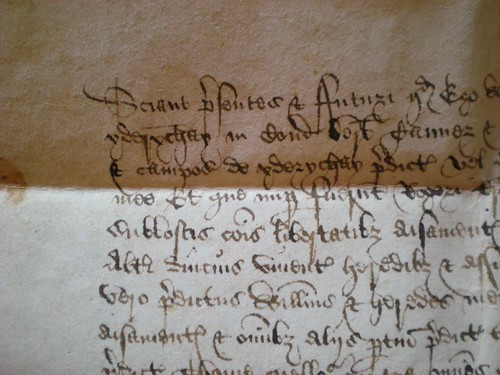
After a couple of glasses of red wine late one night when everyone else in my household was asleep, I decided I needed this deed written in Latin on vellum in 1518. I pressed the buy button on the screen, and a bit more than a week later, a bit of 16th century Derbyshire was posted to me from St Petersberg, Florida. It is apparently a grant from William Haae to Thomas Mellour, tanner, and his wife Alice, of lands, tenements, rents and services within the town of Idridgehay. It is witnessed by Thomas Crane (chaplain), Richard Gaskyn, and Thomas Bywater. In my internet enquiries into 1518, I discovered that Tom and Alice got some other land the same day (see item 381).
I picked this one because it was from the reign of Henry VIII, and because 1518 is a long time ago and is kind of the cusp of what I regard as the recent past — of my culture at least — beyond which it all starts to blur. Our calendar had not even been adopted yet, which might I suppose explain why my deed is dated 10 Hen 8th. (Henry was still going gangbusters with his first wife, Catherine of Aragon, part-English but mostly Pyrenean.) The beginning of the Tudors (e.g. Henry’s dad, Henry and Henry’s three kids who succeeded him as sovereign including the first and penultimate Elizabeth who got Cate Blanchett an Oscar nomination) roughly equates with the end of the Middle Ages, the reformation, and the introduction into Europe of the printing press in 1454. Just before that, the crusades had come to an end when no one could be bothered getting it together to get Constantinople back from the Moslems after it fell in 1453, but the peace of Europe arranged by Cardinal Wolsely in the year of my deed was all about uniting against Islam.
Coffee is said to have reached Europe in 1517, but that seems to mean Constantinople. Columbus was just dead; marmalade had just been invented. Martin Luther had posted his 95 theses, signalling the birth of Protestantism, to the door of a German church the year before. He would go on to translate the Bible from the language of my deed into German, and Henry was prompted to commission an official English translation too. Luther was really an anti-corruption campaigner, teaching that you could not buy forgiveness for sins in the form of indulgences issued by the Catholic church.
As a result of buying this bit of animal skin, I learnt about the Field of the Cloth of Gold, a 1520 camp-out chat-fest between Henry and his French counterpart. There was a bit of rivalry there, so they met in a field on the border of French France and England’s territory in Calais, Henry and 6,000 nobles having crossed the Channel, and the frog king having deigned to meet on English soil, just inside Calais. Henry built an 8 foot high brick foundation for his tent. And quite a tent it was, being almost 100 metres long on each side. Its walls were 10 metres high, and painted to resemble stones. It had an ornate wooden ceiling topped by a gabled oiled cloth roof painted to resemble slates. The golden fountains gushed claret and beer, everyone present was absolved of their sins by Cardinal Wolsey, and a fire-breathing dragon flew overhead during mass. There was jousting, games, and banqueting. The English royal household accounts disclose the acquisition of 9,100 plaice, 7,836 whiting, 5,554 soles, 2,800 crayfish, 700 conger eels, 3 porpoises and a dolphin.
I said 1518 was kind of the cusp of the recent past. I don’t remember reading anything older than Shakespeare (who was born in 1564 and wrote Hamlet in about 1600) as an entertainment. I consider everything pre-J.S. Bach (who was born in 1685 and wrote the ‘Goldberg Variations’ in 1741) to be exotic. But the work of the deliciously exotic composers whose work I am familiar with post-dates 1518. I mean Monteverdi’s Vespers of 1612 sound damn old to me. Josquin des Pres, a contemporary of my deed, I can vaguely connect with. And I am sure I have sat through some John Taverner, another contemporary. Thomas Tallis was just a kid. Once you move into the second half of the 16th century though, the relief of familiarity is at hand: Monteverdi, Palestrina, Orlando di Lassus.
On the other hand, in visual art, the artists of 1518 are familiar. The Medicis were running Venice. Leonardo was still alive at 66. The ‘Mona Lisa’ was a teenager, as was ‘David’, whose creator was 44. The ceiling of the Sistine Chapel had dried 6 years before. The Prince was just 5. St. Peter’s in Rome was 6 years into its 20 year construction (while St. Mark’s in Venice had been there for over 400 years). Erasmus was lecturing at Cambridge. Hieronymous Bosch was just dead, but Durer was on the scene.
So I’m happy to own something nearly 500 years old which was kicking around in these times. More photos follow. If you want to see it, come by my chambers one day.




That absolutely rocks. What an awesome thing.